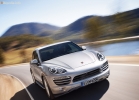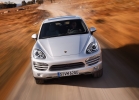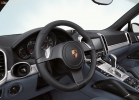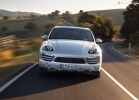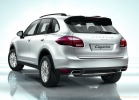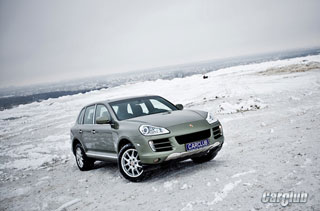Porsche Cayenne test drive since 2010 SUV
Basebusters
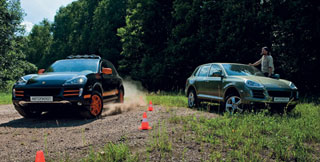 This world is actually square, not round. And the stars in the sky are LED. And they are not burning at all from hot gases, but fuel from small batteries. It is traditionally customary to think wrong, but what are traditions? Under the tradition of eating by cannibals, every second photo referter can easily fit the traditional sale of half of the tickets one way. And under the traditions of the highest sports achievements Porsche, the marketing concept of Cayenne, dedicated to victories at the Transsyberia marathon, is easily laid. So, in today's test, the autopilot is two destroyers of traditions: one diesel, the other black -orange.
This world is actually square, not round. And the stars in the sky are LED. And they are not burning at all from hot gases, but fuel from small batteries. It is traditionally customary to think wrong, but what are traditions? Under the tradition of eating by cannibals, every second photo referter can easily fit the traditional sale of half of the tickets one way. And under the traditions of the highest sports achievements Porsche, the marketing concept of Cayenne, dedicated to victories at the Transsyberia marathon, is easily laid. So, in today's test, the autopilot is two destroyers of traditions: one diesel, the other black -orange. In the old days, you win the formula today - you sell tomorrow it was considered almost a key in car marketing. Porsche adhered to this policy. Moreover, it was far from always worth the Statgart of money in the literal sense of the word. Hundreds of private stables who threw their Porsche 911 personal training for various titles and cups of their varying degrees of racing training, worked for the image of the brand as well as possible. But here the car itself works for itself. Actively, for a good 70 years now-and I begin to consider from the Porsche Typ 64 racing Porsche TYP-among the company's sports cars, if there were samples that are not true works of racing-auto-billed art, then only by mistake. But with Cayenne this formula does not work at all. Well, he has nowhere to win. For heavy (yes, frankly, for the lungs) rally, the car is not suitable for a number of constructive reasons, and Porsche Cayenne does not fit into any discipline. The German marketers had to think tightly. Agree, it is not only a car in the lineup that is not only famous for the Middle Eastern oligarchs that is extremely unpleasant for the image of the brand, but also has a direct relationship with VW Touareg, which has long lit up on the Dakar series (even in the form of a prototype Race Touareg). All this preamble, in fact, leads us to the main character of today's test: Porsche Cayenne S Trans-Syberia, a car created based on a real combat rally version born to win the Moscow-Ulan-Bator race. And so that he was not so boring, for comparison we took the most unsolved by the SUV from Porsche - Cayenne Diesel.
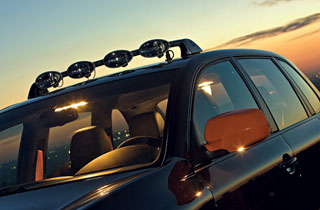
The main external distinguishing features of Cayenne S Transsyberia are bright design elements (stickers on the sides, wheeled wheels, mirrors and spoiler above the rear door) and a chandelier consisting of four headlights Hella. All this practically does not affect the technical parameters, but it works just great on the image.
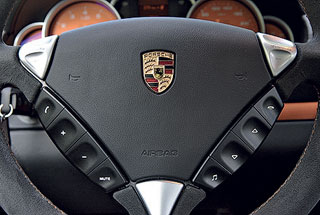
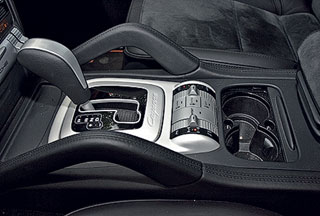
The steering wheel is lined with alcantara and very pleasant to the touch. But here are orange devices for my run, far from the best choice. Elements of control of all -wheel drive transmission and pneumatic suspension are in no way different from the rest of Cayenne.
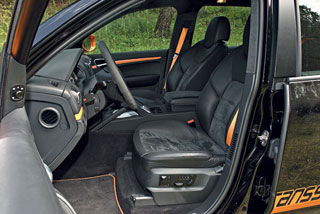
The theme of black-orange external design also switches to the salon. This does not add functionality, but there is a feeling of some involvement in motorsport.
So different.
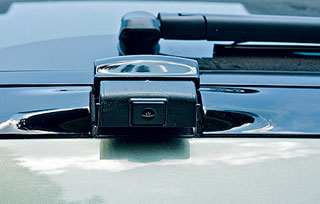
The rear view video camera leaves its nest only when the rear gear is turned on. A very useful function in our difficult Russian conditions: the camera is always clean.
About the appearance of Cayenne, no matter how they are restored and facelifting, everything has long been said. So I will turn immediately to our testable. You know, but the first thought that arises when looking at these two almost identical cars: what different they are! Transsyberia famously beats the eyes with a combination of black body and orange details. A pair of stickers on the sides and bumers, a spectacular chandelier with Hella headlights, rally wheels, orange mirrors and spoiler - and heavy -looking Cayenne is transformed into an athlete. The result was confirmed by the tests of folk love, quite accidentally conducted by our test team. If you just leave beautiful Cayenne Diesel in the parking lot, people walk by without looking back. But Transsyberia collects a crowd of connoisseurs of seconds in ten. By the way, for Cayenne Turbo, there is also an option for designing Transsyberia. Want to stand out? Only four million recommended rubles (seven, if it is Cayenne Turbo) - and attention is provided to you. True, you pay in this case not only for the appearance, but also for additional comfort, because the salons of the tested cars are also slightly different.
Orange sky.
Inside the differences of our simply Cayenne and not just Cayenne not to say that they are striking, but significant. I must note that I really liked the Trannssyberia salon. It is almost completely made of Alcantara. Firstly, it is stylish and, let’s say, sports, and secondly, the rattle of plastic immediately disappears, I, to my surprise, found when the first trip to Cayenne Diesel. But how vividly and freshly look in Transsyberia orange inserts in the dashboard and doors! But the seat belts and the scale of the devices are also orange. In general, the song is an orange sky, remember an orange camel? So I remembered. Positive. In Cayenne Diesel, everything is much more evenly and even a little severe. Gray-black-dark interior and almost no frills. But after all, bad luck - the readability of black appliances with yellow backlight turned out to be much better than that of a rally competitor.
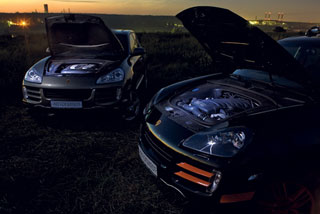
Cayenne S Transyberia, in addition to the magnificent DFI V8 atmospheric engine with a capacity of 405 hp. (from the senior GTS model), has reduced gear rates of the main programs to ensure maximum acceleration dynamics
Everything is the same.
What are thousands of words about appearance and interior if cars do not move? So I will finish tormenting you with such details and give a picture, so to speak, from behind the steering wheel. Only before starting movement, you need to make some clarity into the technical equipment of specific versions of Porsche we received for the test. The essence of the filling of Cayenne S Transsyberia is that this is almost the real Cayenne GTS. In any case, the DFI V8 engine with a volume of 4.8 liters here is exactly from the older version, 405-horsepower. This means that we are dealing with the most powerful hopeless unit presented in the Cayenne line. The second car flaunts economical, but unconventionally weak for Porsche 240-horsepower 3-liter V6 TDI diesel, borrowed from the VW Touareg. Although ... at a torque, he is at 50 nm ahead of the V8. According to other parameters, the advantage on the TRANSSYBERIA side is only in the presence of the rear interventure location of the differential, transferring the main pairs of 4.1: 1 and additional aerodynamic shields under the bottom. Both test Cayenne also turned out to be equipped with active reptile stability stabilizers. By the way, this is what I will tell you: both cars, if you look from the bottom side, have undisguised stickers with Volkswagen inscriptions ...
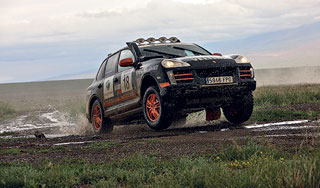
Raline version of Cayenne S Transsyberia Spec-2008
According to the results of the 2007 Trans -Siberian rally Porsche Cayenne S Transsyberia, Cayenne S Transsyberia cars took the first three places. For the new Trans-Siberian rally of 2008, Porsche optimized a car released by a limited series. Changed components are offered by client teams of the whole world in the form of a set for re -equipment. When processing Cayenne S Transsyberia, in the foreground there were an additional increase in patency and optimization of the setting of the chassis. So, the 2008 version of this successful racer for long distances is equipped with enhanced protection of the bottom of a new form. In order to increase the angles of entry and the congress, the cladding of the front and rear parts was subjected to changes. Off -road tires with an aggressive pattern of BFGOODRICH dimensions 265/65 R18 R increase the road lumen by 30 mm. The pneumatic suspension received a new setting. Standard shock absorbers were replaced by rally. As a result, compared with the previous version, the fluctuations of the car in fast areas have noticeably decreased. Changes in the design relative to the serial Cayenne S, taken as a basis, also include a Schneorkel on the air intake, a winch, a modified PDCC system (blurry stabilizers of the peretial stability on both axes), an increased gear ratio of the main pairs (main pairs from Cayenne GTS), and blocking inter -normal differentials, blocking. Sports exhaust system, safety frame, processing of the salon space for installation of spare wheels and equipment, turning the parking brake with a lever, not a pedal, transfer of a suspension and transmission control panel to the central console to the place of a multimedia center, navigation equipment, as well as a certain number of not so significant changes .
He said: let's go! ...
And, oddly enough, I went. In today's list of testing and measurements of maximum speed for steam with overclocking. But if about the first I rather trust to tell our drive-expert Evgeny Speransky, then I will dwell on the latter in detail. No, I will not pour epithets and talk about the uterine roar V8, flavored with a special lever in the exhaust tract. It’s better to tell you: in the technical characteristics table, the declared acceleration dynamics from 0 to 100 km/h for Cayenne S Transsyberia is 6.5 s, and Cayenne Diesel is 8.3 s. What was our surprise when Datron recorded the average acceleration of 8.3 C for - you will be surprised - but it is for Transsyberia! Everything is honest, gasoline 98th, ideal landfill conditions, almost complete absence of wind-and such a failure. Okay, it would be half a second, but not two! Yes, and seven kilometers of the dynamic road was not enough to achieve the maximum 251 km/h (acceleration had to be stopped 235 km/h). However, I want to praise, I’m not afraid of this word, the reference brake mechanisms of Porsche. The regime of numerous races of strat-break up to 100 km/h-stop during the measurements of the dynamics was given to them with ease without a hint of overheating. However, let the cars rest - we will ride on the paving stones in order to evaluate the noise in the salons. Although ... Everything is very predictable here: Cayenne Diesel creaked with plastic and noise with low -profile rubber with 20 '' discs more than Alcantare Transsyberia on the rally 18 '' wheels.
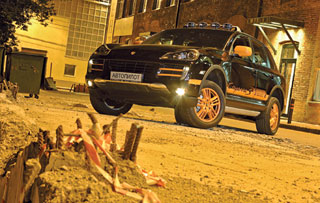
The environment is inhabited by Cayenne S Transsyberia is far from rally-raid tracks. There is such a term that includes overcoming broken asphalt roads, curb assaults and a detour of traffic jams in the GA zones. It sounds trite: urban off -road
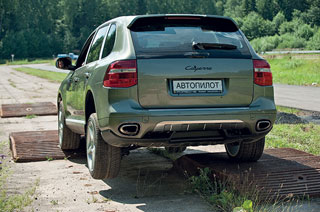
And here is the previously announced problem with the strokes of the squeeze. In this photo, the car moves in the upper position of the suspension. There are strong hanging. True, electronic wheel bracket systems cope with the situation playfully.
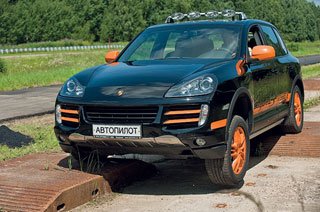
And in this frame the height of the suspension is average, and the wheels calmly drop almost to the ground. Honestly, a much greater role in this is played by the weighting of cars. In Transsyberia, it is almost equal to the perfect and is 51:49. Pay attention to how smoothly the car is in the long time.
Great suchery of the Moscow Region.
But do not we want to want from SUV the same as from the rest of Porsche, and do not try that the cars should be able to best, that is, off -road? Having left for hard field primers, I immediately felt a lack of energy intensity of the suspension. In the Terrain position, that is, one step above the standard, frankly lacked the moves of the end. The result was constant blows of levers on limiters. And in the Normal position, the problem arose on the part of a lack of road clearance. Dry and hard ruts strove to knock the car on a poorly protected bottom. But if you move slowly and thoughtfully if possible, then more or less returns to normal. For example, the assault of approximately 70% of the ground rise was a successful Transsyberia the first time even without much overclocking. In this case, the rear inter-axial differential and the excellent operation of the track control program helped. In fairness, it is worth noting that Cayenne Diesel did not master the same rise without acceleration. As for various alternating obstacles (both artificial and natural), in this case they did not actually ... obstacles. Despite the fact that the suspension moves frankly were not enough even with the PDC stabilizers disconnected (automatically disconnected when the lowering range of the RCP is turned on), the electronics worked five points. That is, it turns out that these are still SUVs? Although, of course, it was difficult to draw conclusions - it was already painfully dry. I wish they were in the chernozem after the rain ...
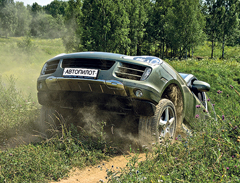
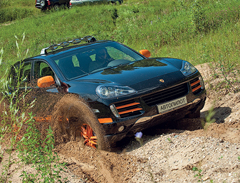
It is possible, but rather it is still impossible. The car rides perfectly on the sand, but the creak of stones that fell into the brake mechanisms made us stop experiments. Cool soil climbs were easily given to both cars. But the absence of the rear inter -axial lock from Cayenne Diesel required an obstacle to the course.
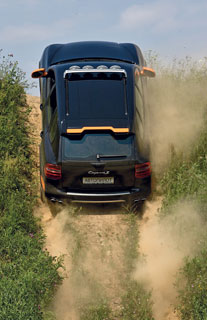
This is an amazing feeling: you just hold the gas pedal, and the car with jerks, several centimeters, climbs up with slip
Conclusions beg.
I will end this narrative (it is a comparative test of two cars), oddly enough, in a quote. My fellow on Peru from The Sunday Times, Andrew Frenkel, in an article dated November 17, 2002, wrote about Cayenne: Great Car, if online it was -porsche (into a translation - a magnificent car, unless it were Porsche). I, in turn, will modestly agree with him. Indeed, despite the increased sports component and solid support in the form of victories in races, it was not possible to make a car, worthy of the Porsche brand, from the driver, but still. So what is the purpose of this Cayenne? It seems to me that now I know this ... When examining the cabin, we found a special bag for skis, packed in the back of the rear sofa. Imagine only: black with orange Cayenne Transsyberia on a white alpine resort parking from snow. And at this time, your favorite Porsche 911 patiently stands in the garage, waiting for the owner to return from vacation. He waits to finally light up and show what the car of the famous brand really should be.
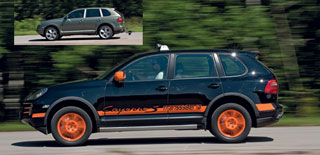
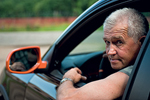 EXPERT OPINION
EXPERT OPINION Evgeny Speransky,
Drive-expert of autopilot magazine
Balance of pleasure and security
With the apparent identity of the designs of tested cars, they noticeably differ from each other in behavior. On the test, the rearrangement with a distance of a strip of 16 m received quite high speeds - on Transsyberia reached the result of 80 km/h, and on Cayenne Diesel, which turned out to be much more acute, 85 km/h. The PSM course stabilization system actively intervened in our assessment of controllability. We tried to undergo a rearrangement with both turned on and with a disconnected system, but at about the same speeds it intervened in control, regardless of the driver's desire. At Transsyberia, with a sharp detour of an obstacle, the stabilization system was included earlier, already in the first phase. The maneuver speed starting with 75 km/h was reduced by branding both at the first turn of the steering wheel and when changing the strip, stabilizing the car until the control is completely restored. With an increase in the speed of movement, the limit of saturation in brake dynamics at 81 km/h occurred, and in braking Cayenne Trans-Syberia began to go beyond the designated strip with the front wheel. With Cayenne Diesel, everything was different. The car changed the lane more actively, and the system began to work a little later (77 - 78 km/h) and only in the restoration mode of trajectory stability. Saturation occurred at 85 km/h, but manifested in the form of a skid, which is understandable: due to a high reaction in the first phase, the reserve of course stability in Cayenne Diesel. Nevertheless, the system successfully coped with the task, allowing you not to lose control of the car. The reason for this different behavior lies in different weightlifts, and above all in tires. Low profile (40 in Cayenne Diesel), as a rule, provides a higher reaction. The higher the profile, the more late. As a result, Transsyberia with a rubber band 55 profile showed itself less acute and showed a clear tendency to insufficient rotation. An important role here is played by the presence under the rear wheel wheels of Transsyberia spacers that increase the track. Most likely they are designed to compensate for the excess of the rotation obtained on these tires. Summarizing, I can say: both Cayenne are good. A large amount of work is felt - cars are perfectly adapted for an amateur in the sense that they adequately respond to the driver’s actions, not allowing, however, large liberties. Balance of pleasure and safety is observed.
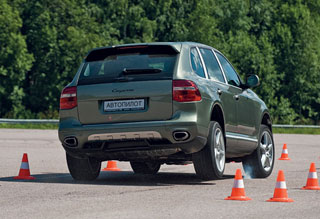
The tested Cayenne Diesel was shod in low -profile rubber, which, of course, played in his favor. In fact, the car turned out to be much more driver than an opponent with racing genes.
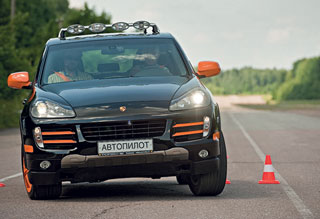
The installation of rally 18-inch wheels so influenced the manageability of a serial car that Porsche engineers had to install spacers under the rear discs, increasing the track.
Technical characteristics (manufacturer data)
Porsche Cayenne Diesel
Type of body wagon
Number of seats 5
Engine, type V6, diesel with a turbine
Engine, volume, l 3.0
Maximum power, L.S. per rival 240 for 4000-4400
Torque, NM for rpm 550 for 2000-2250
Transmission Hydromechanical adaptive six -speed Tiptronic S control from the steering wheel
Type of all -wheel drive is constant full with a lock of the center differential
Acceleration to 100 km / h, from 8.3 / 9.7*
Maximum speed, km / h 214 /210*
The declared fuel consumption is a city/highway, l per 100 km 11.6/7.9
Porsche Cayenne S Transsyberia
Type of body wagon
Number of seats 5
Engine, type V8, gasoline atmospheric
Engine, volume, l 4.8
Maximum power, L.S. on rpm 405 for 6500
Torque, NM for rpm 500 by 3500
Transmission Hydromechanical adaptive six -speed Tiptronic S control from the steering wheel
Type of all -wheel drive is constant full with a lock of the center differential
Acceleration to 100 km / h, with 6.5 / 8.4*
Maximum speed, km / h 251 /236*
The declared fuel consumption is a city/track, l per 100 km 20.6/13.9
* Autopilot measurements
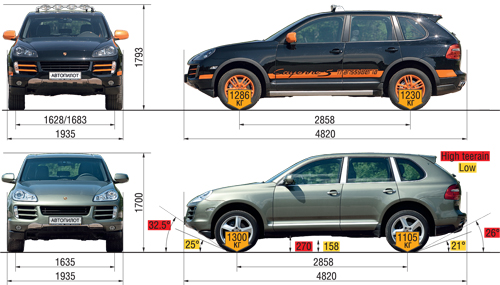
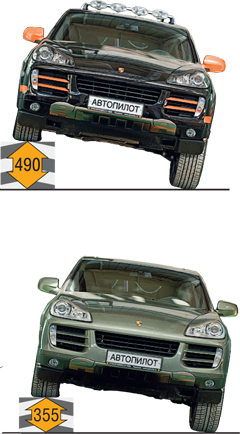
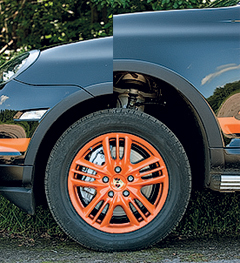
In all off -road positions, the suspension decreases the collection stroke, which negatively affects the more or less fast (more than 20 km/h) motion along the crossed terrain and broken primers.
Text: Dmitry Lyakhovenko
Photo: Alexander Davidyuk, Alexey Vasiliev, Porsche Automobil Holding SE
A source: "Autopilot"

